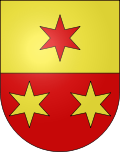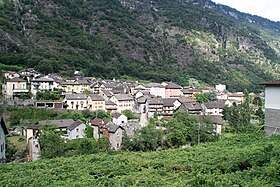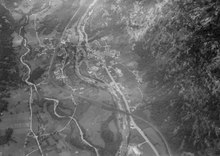Giornico
| Giornico | |
|---|---|
| State : |
|
| Canton : |
|
| District : | Leventina district |
| Circle : | Giornico district |
| BFS no. : | 5073 |
| Postal code : | 6745 |
| Coordinates : | 710460 / 139 748 |
| Height : | 391 m above sea level M. |
| Height range : | 333–2740 m above sea level M. |
| Area : | 19.52 km² |
| Residents: | 858 (December 31, 2018) |
| Population density : | 44 inhabitants per km² |
| Website: | www.giornico.ch |
|
Giornico |
|
| Location of the municipality | |
Giornico [dʒorˈniko] , in the Alpine Lombard local dialect [ʒjorˈniːk] , German obsolete Irnis, is a political municipality and the capital of the Giornico district ( Leventina district ) in the Swiss canton of Ticino .
geography
The village lies in the bottom of the Leventina valley on both sides of the Ticino River . An inhabited river island lies between the village parts. The small village of Altirolo northwest of Giornico belongs to the municipality . Coming from the north, Giornico is the first place with a southern character.
The municipality borders on Faido in the north, Sobrio in the east, Bodio in the east-southeast , Personico in the south, Frasco in the southwest and Chironico in the west .
history
The village is first mentioned around 935/40 (copy from 1613/1619) in the phrase "Ego presbiter Franciscus de Iudicibus Giornicensis"; In 1202 there is talk of "sancto N [icolao] de Iornico". The name is possibly based on the Celtic * iuris or * iurom "wooded mountain".
In the Middle Ages, Giornico, together with the three Ambrosian valleys, belonged to the cathedral chapter of Milan and was a court of the Leventina. It was first conquered by Uri and Unterwalden in 1403 .
On December 28, 1478, as a result of the Confederation's claims to power over the Alps, the Battle of Giornico , the Battaglia dei Sassi Grossi, in which the Swiss defeated the Milanese. It sealed the rule of Uri over the Leventina , which lasted until 1798 .
In 1803 Giornico, like the entire Leventina, came to the newly founded Canton of Ticino.
population
| Population development | |||||||||||||
|---|---|---|---|---|---|---|---|---|---|---|---|---|---|
| year | 1745 | 1850 | 1880 | 1900 | 1950 | 1970 | 1980 | 1990 | 2000 | 2010 | 2017 | ||
| Residents | 510 | 707 | 2147 | 768 | 829 | 1389 | 1305 | 1048 | 885 | 848 | 873 | ||
Attractions
The village is surrounded by vineyards and chestnut forests. The old village center, which is classified in the inventory of Swiss sites worthy of protection (ISOS) as a site of national importance worthy of protection, consists predominantly of stone houses. Giornico is particularly known for its Romanesque churches.
Churches
- The Church of San Nicolao is the most important Romanesque architectural monument in Ticino and dates from the 1120s. It contains, among other things, capitals decorated with animal motifs and wall paintings from the 13th and 15th centuries, including a tricephalus , the repeatedly forbidden representation of the Trinity by means of merging faces.
- The parish church of San Michele was first attested in 1210; the current choir dates from 1644, the current nave from 1787.
- The church of Santa Maria di Castello stands on the site of a castle that was destroyed in 1518 at the instigation of Uri and integrates the walls of the former palace.
- The church of San Pellegrino in the Altirolo district contains the most important fresco cycle of the late 16th century in Ticino.
Houses and museums
- In the center of the village of Chironico there is a six-storey residential tower , which is associated with the 10th century Bishop Atto von Vercelli . The current structure goes back to the 14th century.
- The Casa Stanga is an old inn from the 16th century, the facade of which was decorated with painted coats of arms of famous guests around 1589. Since 1972 it has housed the Leventina Regional Museum.
- La Congiunta is a museum designed in 1992 and dedicated to the sculptor Hans Josephsohn .
bridges
- Two Romanesque stone bridges, over which the medieval mule track led, connect the right-hand part of the village via a Ticino island with the district on the left of the river. They were first mentioned in the 14th century
- The Biaschina Viaduct, with a span of up to 160 m and a height of 100 m, is the most striking structure on the A2 motorway and was built between 1978 and 1980.
Further sights and monuments
- the battle memorial from 1937 (sculptor: A. Pessina)
- Schalenstein on the Alpe Cramosino in the Sprügh district (1720 m above sea level)
- Cramosina waterfall
photos
Transport and economy
For centuries, Giornico was a farming and trading village that lived off the Gotthard traffic.
From the commissioning of the Gotthard Railway in 1882, it was unable to benefit like other municipalities despite having its own station, as this had to be built two kilometers outside the municipality due to the difficult topographical conditions. The sections to the neighboring Lavorgo and Bodio stations with 26.8 and 27 ‰ have the greatest gradients of the Gotthard Railway. The later relocation of the train station more towards the center of the community did not stop the trend; today the station is closed. The route of the Gotthard Railway directly above Giornico is characterized by two spiral tunnels following one another (Pianotondo and Travi Spiral Tunnel) on the left side of the Ticino Valley, which are collectively known as the Biaschina loops. - The longest and highest motorway viaduct of the A2, the Biaschina viaduct, is located near Giornico .
The steelworks of the Monteforno company , opened in 1946, accelerated the change to an industrial location ; however, they were closed in 1994. A replacement is the Tensol Rail, which moved to Giornico in 2000 and is active in the area of railway accessories and rail maintenance. Around two thirds of the active population are commuters.
Sports
- Associazione Calcistica Giornico
Personalities
literature
history
- Mario Fransioli: Giornico. In: Historical Lexicon of Switzerland . February 11, 2008 , accessed December 31, 2019 .
- Kuno Müller: Frischhans Teiling. The hero of Giornico. Haag in Komm., Lucerne 1970.
- Thomas Schibler: Battle of Giornico. In: Historical Lexicon of Switzerland . November 16, 2005 , accessed December 31, 2019 .
- Celestino Trezzini : Giornico. In: Historisch-Biographisches Lexikon der Schweiz , Volume 3: Galmiton - Giovanni. Attinger, Neuenburg 1926, p. 520 f ( digitized version ).
Art history
- Piero Bianconi , Arminio Janner: Giornico. In: Arte in Leventina. Istituto Editoriale Ticinese, Bellinzona 1939, pp. 15, 18, 31, 42, 47, 49, 51, 54, 58, 85, 93, 103.
- Piero Bianconi (Ed.): Giornico. In: Inventario delle cose d'arte e di antichità. Le Tre Valli Superiori. Leventina, Blenio, Riviera. Grassi & Co., Bellinzona 1948, pp. 82, 89, 92, 94-96.
- Art guide through Switzerland. Completely re-edit Output. Edited by the Society for Swiss Art History. Volume 2. Bern 2005, ISBN 3-906131-96-3 , pp. 541-546.
- Peter Märkli: La Congiunta Foundation. House for reliefs and half-figures by the sculptor Hans Josephsohn. Hatje, Stuttgart 1994.
- Simona Martinoli u. a .: Guida d'arte della Svizzera italiana. Edited by the Society for Swiss Art History. Bellinzona 2007.
- Johann Rudolf Rahn : I monumenti artistici del medio evo nel Cantone Ticino. Tipo-Litografia di Carlo Salvioni, Bellinzona 1894, pp. 98-113.
- Anton-Heinz Schmidt: Switzerland - theater made of stone or unbiblical in Ticino churches. The little explored churches of San Nicola in Giornico, San Vittore in Muralto. AH. Schmidt, Aigen-Voglhub 2011.
Web links
- Giornico on the ETHorama platform
- Official website of the municipality of Giornico (giornico.ch, Italian)
- Data from the municipality of Giornico
- Office for Statistics of the Canton of Ticino: Giornico (Italian)
- Website about Giornico (giornico.com, German, English, Italian and Japanese)
- Federal inventory ISOS: Giornico
- Giornico: inventory of cultural assets of the Canton of Ticino
- Giornico on ticinotopten.ch
- Ticinoin photo: Battle of the Sassi Grossi Memorial on www.flickr.com
- Giornico on elexikon.ch
Individual evidence
- ↑ Permanent and non-permanent resident population by year, canton, district, municipality, population type and gender (permanent resident population). In: bfs. admin.ch . Federal Statistical Office (FSO), August 31, 2019, accessed on December 22, 2019 .
- ↑ a b Lexicon of Swiss municipality names . Edited by the Center de Dialectologie at the University of Neuchâtel under the direction of Andres Kristol. Frauenfeld / Lausanne 2005, p. 388 f.
- ↑ According to the Historisch-Biographisches Lexikon der Schweiz , Volume I, pp. 333–335, the Ambrosian valleys were donated to the Milan Chapter by Archbishop Arnulf II of Milan (996–1018).
- ↑ Mario Fransioli: Giornico. In: Historical Lexicon of Switzerland . February 11, 2008 , accessed December 31, 2019 .
- ↑ Mario Fransioli: Giornico. In: Historical Lexicon of Switzerland . February 11, 2008 , accessed December 31, 2019 .
- ↑ List of sites of national importance , directory on the website of the Federal Office of Culture (BAK), accessed on January 10, 2018.
- ↑ Art guide through Switzerland. Completely re-edit Output. Edited by the Society for Swiss Art History. Volume 2. Bern 2005, ISBN 3-906131-96-3 , p. 542 f.
- ↑ Art guide through Switzerland. Completely re-edit Output. Edited by the Society for Swiss Art History. Volume 2. Bern 2005, ISBN 3-906131-96-3 , p. 543.
- ↑ Art guide through Switzerland. Completely re-edit Output. Edited by the Society for Swiss Art History. Volume 2. Bern 2005, ISBN 3-906131-96-3 , p. 543 f.
- ↑ Art guide through Switzerland. Completely re-edit Output. Edited by the Society for Swiss Art History. Volume 2. Bern 2005, ISBN 3-906131-96-3 , p. 545 f.
- ↑ a b Art guide through Switzerland. Completely re-edit Output. Edited by the Society for Swiss Art History. Volume 2. Bern 2005, ISBN 3-906131-96-3 , p. 544.
- ^ Tower of Bishop Atto
- ^ Museo di Leventina
- ↑ Stone Bridge West (photo)
- ↑ Art guide through Switzerland. Completely re-edit Output. Edited by the Society for Swiss Art History. Volume 2. Bern 2005, ISBN 3-906131-96-3 , p. 546.
- ^ Franco Binda: Il mistero delle incisioni. Armando Dadò editore, Locarno 2013, pp. 70–71.
- ↑ Cramosina waterfall at ethorama.library.ethz.ch/de/node
- ↑ Mario Fransioli: Giornico. In: Historical Lexicon of Switzerland . February 11, 2008 , accessed December 31, 2019 .
- ↑ Braun, Adolphe, Photographic Views of the Gotthard Railway , Dornach in Alsace, approx. 1875
- ↑ Dietler, H .: Gotthardbahn in Röll, V. Freiherr von: Enzyklopädie des Eisenbahnwesens , Volume 5. Berlin, Vienna 1912, p. 356 and 358 on www.zeno.org/Roell-1912
- ^ Associazione Calcistica Giornico
- ^ Peter Märkli: La Congiunta Foundation. House for reliefs and half-figures by the sculptor Hans Josephsohn. at portal.dnb.de (accessed on May 3, 2016.)











